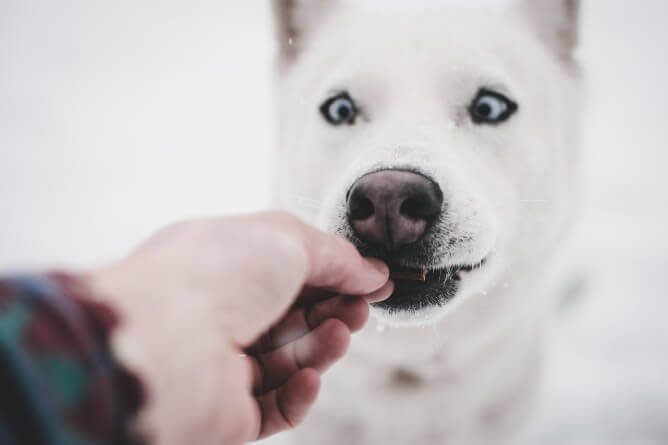The Rights and Wrongs of Dog Treats

An unspoken fact about owning a dog is that you’ll probably have half-empty packets of dog treats all over your house. Whether treats for training, dental chews to keep your dog’s teeth clean, calming or CBD dog treats, or just treats to spoil them and keep them entertained.
Dog treats of every shape and flavor can be found in most stores, online, and you can even make them at home. But some treats, or even good treats used in the wrong way, can cause health problems or teach your dog bad habits.
So what is the right way to feed your dog treats and what should you avoid?
We asked Lindsay Tracy, Vice President of Product Development at 5-star-rated Redbarn, for her tips on how to use dog treats — and how not to.
The Right Way to Use Dog Treats
Treats are a good way to get your dog’s attention between meal times but there are some best practices to consider. Lindsay has six key tips:
1. For training or good behavior
“The most common use of treats is to train a dog. By rewarding a dog with a treat every time it shows good behavior or completes a command such as ‘sit’, the dog will eventually link your command to receiving a treat and happily oblige. You can also involve treats when socializing a puppy in new environments. This is called positive reinforcement and is the basis of dog training.”
2. Hold dog treats close
“The best way to feed a dog treat is to hold the treat close to its face or nose, preferably just under the mouth. This way, the dog won’t have to jump up at you to grab the treat or snap it away from your hand. Families with small children should take particular care of this. If you find that your dog is still snapping, try to offer the treat in the palm of your flat hand.”
3. Look for safe ingredients
“Always check the treat label for ingredients which could be harmful to your dog. Even treats purchased online should have a photo of the label or a list of ingredients. There are hundreds and thousands of treats on the market but not all of them are healthy, or even safe.
“You should also be extra vigilant if your dog has any food allergies, as trigger ingredients could cause an allergic reaction.”
4. Use dog treats in moderation
“Avoid feeding your dog an excessive amount of treats as this could cause unhealthy weight gain. No matter how small, treats still contain calories, so this should be considered alongside your dog’s normal diet. Most treat packets will have feeding recommendations for you to follow but you can also consult your vet for advice about how many treats to give your dog.
“As a general rule, dogs that are active or young will be able to enjoy more treats because they can burn off more calories than older dogs. The size of your dog and existing health conditions can also play a role.”
5. Respect their space
“Allow your dog to enjoy treats in their own space. Try to keep children and other dogs away to avoid friction and possession issues. This will help them to enjoy their food and feel safe in their environment.”
6. Provide water
“Always have a fresh bowl of water available for your dog. This is important when giving normal food or treats, particularly if you choose a dry food brand. Water is a crucial nutrient and dogs can easily dehydrate.”
The Wrong Way to Use Dog Treats
Dog treats are a fantastic reward and incentive for your dog but you should also be careful of a few factors. Lindsay lists five no-nos for their use:
1. While a dog is over-excited
“Dog treats should be used to reward the behavior we would like to see in dogs. Giving your dog a treat while it is over-excited can encourage undesirable behavior such as jumping up or barking for food, so wait until your dog is calm before providing treats. Teaching your dog to sit for food and treats is a good routine.”
2. Holding dog treats high
“Don’t hold the treat too high for your dog or dangle it in the air as this will encourage them to jump up and snatch. Jumping could cause an issue if you have small children in the home or people with an illness or injury.”
3. Using human food
“Although it may be tempting, avoid giving your dog human food and snacks. Not only can human food contain toxic ingredients for dogs, such as chocolate, but it’s also higher in calories and will not provide your dog with the correct nutrients. It can also cause your dog to put on unnecessary weight.”
4. Feeding dog treats excessively
“Do not feed your dog more than the recommended amount. You can find feeding guidelines on the treat’s label to help you give the correct amount of treats or ask your vet if you are unsure. Feeding your dog too many treats can cause weight gain and even health problems in diabetic dogs or older dogs.”
5. During or instead of mealtimes
“Make sure that dog treats remain a treat for your dog and do not slowly replace mealtime. Your dog’s predominant food source and primary source of nutrition should be their normal dog food, as dog treats can be higher in calories and fat. Dog treats should mainly be used for training and special rewards.”


